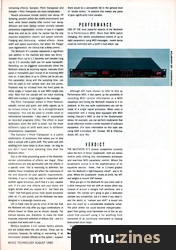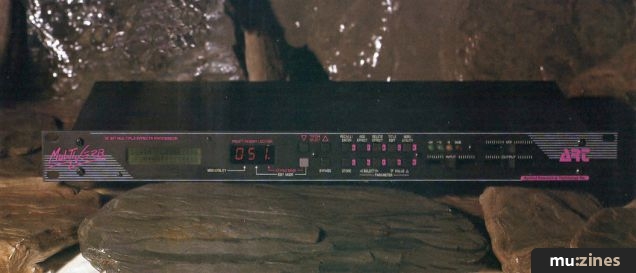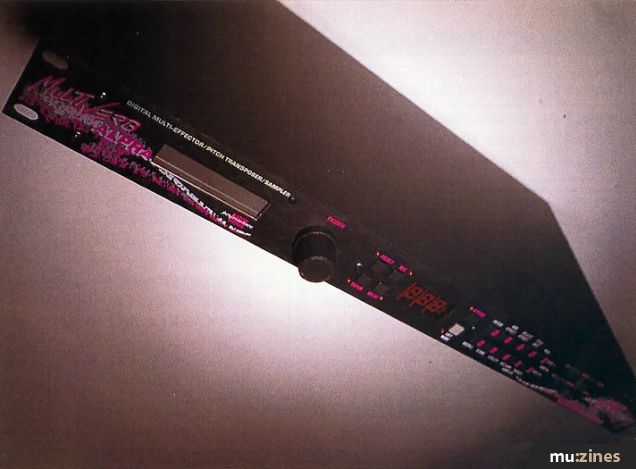Magazine Archive
Home -> Magazines -> Issues -> Articles in this issue -> View
ART Multiverb III | |
ART Multi-fx ProcessorArticle from Music Technology, August 1990 | |
As even the most modest MIDI studio becomes a powerful tool for the creation and recording of music, sound processing becomes a more essential part of it. Tim Goodyer checks out ART's latest multi-fx processor.
Like Dr Who, ART's Multiverb is back after another successful regeneration - it looks the same, but how does it perform?

The NOVELTY OF budget studio signal processors has now definitely worn off. In place of the wonder of being able to get reverb that doesn't sound as if it's been produced with the latest in stainless steel bucket technology at a fraction of the price the pros were used to paying for "professional" reverb units, is a high level of expectation of performance and facilities. In other words, we take modern reverb units for granted. But it's worse than this; we now expect digital signal processors to give us a wide range of effects, access to more than one effect at a time and luxuries such as MIDI control - for well under a grand. Where the pro used to keep a rack full of units to cover a variety of applications, modern musicians can turn to a single unit to meet most, if not all, of our needs.
With the market spotted and the technology available, the R&D teams went to work. Yamaha, Roland, Alesis and ART have all delivered a range of attractive and cost-effective multi-fx processors. Of these, New York-based ART are perhaps the least readily recognised in the UK. Yamaha's SPX90 quickly established itself as an industry-standard unit. Roland's DEP series attracted a faithful following. And, as usual, Alesis got the costings down far enough to make them the heroes of the day. ART, meanwhile, produced a line of quality, moderate-cost units that gained approval wherever they appeared.
As its name implies, the new Multiverb III has two predecessors - evidence of ART's policy of continual improvement. The 'III is part of a range of Effects processors intended to offer something for everyone - the budget Multiverb LT (192 presets and choice of three simultaneous processes) and the pro DR-X (with its gates and excitement processes, and the capacity to handle ten simultaneous treatments) complete the line of "reverb" units. The Multiverb III offers four simultaneous processes, 53 families of signal processing, 200 programmable memories and MIDI performance control.
THE BOX
A DETAILED SURVEY of the Multiverb III reveals that it retains many of the Multiverb II's characteristics (see MT November '89). The panel layouts are identical, the display format still uses a seven-segment LED to indicate memory locations and operation mode (Keypad, Edit or MIDI) and a two-line LCD to show the name and effect configuration of a memory location.
Ten buttons handle all the operational functions - everything from selection of effects to naming treatments committed to memory - two more scroll you through the machine's memories, one steps you through the three operation modes and one more allows you to bypass the process.
Three sliders complete the front panel. These control the audio input level, audio output level and the effects mix - used when you patch the unit into the insert points on a mixing desk and need both the processed and dry signal to appear at the outputs. When used in conjunction with aux send and returns, the processor is only required to output the treated signal.
Placing the Multiverb alongside the LT and DR-X reveals that the panels are identical - an indication of streamlined production and marketing strategy.
The rear panel houses MIDI In and Out sockets, and the quarter-inch jacks necessary to accommodate stereo audio processing - the Multiverb III accepts a stereo input signal as well as producing a stereo output. There's also a Remote jack that can be programmed to bypass the unit, step (upwards) through the memories or trigger the sampling facility.
There's still no sign of a mains switch on either panel - but then who really uses them?
OPEN THE BOX
THE HEART OF the Multiverb III is still the tidy, 20-bit processing that gave the Multiverb II its warm sound and low noise floor.
ART'S promo literature claims a better than 90dB S/N ratio, and that the unit possesses some 53 different effects. It depends on how you categorise your effects, of course, (they also claim the unit to be "all new" and "the ultimate refinement in digital signal processing" - in which case they wouldn't have released the DR-X). That the unit is very quiet in operation is indisputable, and the list of available treatments is long, as you will now see.
There are 24 reverb algorithms: Hall 1-3, Room 1-3, Plate 1-3, Vocal 1-3, Gated Slope 1-3, Gated Flat 1-3, Gated Reverse 1A-3B. Digital delays take eight forms: Mono DDL Short (0-1600ms), Mono DDL Long (0-1800ms), Tapped DDL Short (0-1600ms), Tapped DDL Long (0-1800ms, 18 algorithms), Regenerated DDL Short (0-1600ms), Regenerated DDL Long (0-1800ms), Stereo DDL Short (0-1800ms, different increments on left and right channels), Stereo DDL Long (0-2s). The Equaliser offers simple rolling-off of the top end (13 steps 665Hz-15kHz), while the Flanger and Chorus (two algorithms each) can be set either "post" or "pre" other treatments. The remaining effects: Sampler, Pitch Transposer and Sampler + Pitch Transposer are more complicated.
Reverb processes include control over decay, HF damping, position (within the reverb environment) and level, while Gated reverbs offer control over decay, diffusion and level. Delays contain similarly relevant parameters (regeneration, number of taps in a tapped delay line, and so on, while the panner has the only required modulation (depth) and speed controls. Flanging and chorussing - related effects - share width and speed parameters, but where the Flanger uses regeneration, the Chorus has a delay control.
The Multiverb III's sampler represents a significant new addition to the machine and takes two forms - Sampler Short (up to 1.7 seconds) and Sampler Long (up to 2.0 seconds); both use full audio bandwidth. Recording can be triggered automatically (when the Multiverb detects an incoming signal), manually (front panel or footswitch) upon receipt of an incoming MIDI note on. A start delay of up to 100ms can be pre set; this parameter, along with the sampling time, can then be used to edit sample start and end points. Playback may be initiated from the front panel as either single or looped play, or over MIDI (single play only). Note that the sample will not track incoming MIDI note numbers, it just triggers to the message.
The Pitch Transposer comes in three flavours: smooth, normal and quick, and shifts signals up to an octave sharp or flat. As a straightforward transpose, this can be used to create vocal or instrumental harmonies - I also used it successfully on recorded programs (CDs). The effect is least detectable when the shift is small, but the three different types of shift work best in different circumstances - experiment.
The Sampler + Pitch Transposer is a useful combination of processes that allows you to play back a sample with a pitch shift. This works well with anything from bass notes to drum loops - as long as you don't need more sampling time than the Multiverb offers.
Due to the finite processing power of the Multiverb, certain combinations of effects are illegal. Other combinations are only permissible with the effects in a specific order. This is restricting by definition, but whether these limitations will affect the usefulness of the unit depends on your specific requirements. Certainly, if you're using the unit in conjunction with another signal processor, you'll find it a very capable unit. If it's your only effects unit your music will largely dictate what you require of it - but there are "rules" that hold good across most sound processes (after all, it's still sound), and the Multiverb has been designed in a pleasingly musical way.
Life is made easy for you by virtue of the fact that the Multiverb will only offer you legal combinations of effects based on those you've chosen already. The manual advises you, therefore, to make the most musically important selection of effects first - and it's a system that works well in use.
Memory locations 1-110 contain factory presets and are locked when the unit arrives. These can be unlocked, however, for editing or overwriting. If all instruments' presets offered us this option, I suspect there would be a perceptible fall in the general level of "studio stress'. In practice this makes any piece of gear significantly more useable.
PERFORMANCE
ONE OF THE most powerful aspects of the Multiverb III is Performance MIDI. More than MIDI patch changing, this allows simultaneous control of up to eight parameters using MIDI messages - reverb decay could be controlled with a synth's mod wheel, say.
Although ART have chosen to refer to this as Performance MIDI, it also opens up the possibility of recording MIDI control information in a MIDI sequencer and having the Multiverb respond to it on playback. In this way quite sophisticated use can be made of a single signal processor. When used in conjunction with a mixing desk equipped with MIDI muting (Tascam's MM1 or one of the Studiomaster desks, for example), you can perform treatments that would otherwise involve a small mountain of outboard equipment. (For more information on this topic see Using MIDI Controllers, MT, October '89 & Effective Action, MT, June '90).
VERDICT
THE MULTIVERB III'S closest competition currently takes the form of Alesis' Quadraverb - both are stereo multi-fx units offering four simultaneous processes and real-time MIDI parameter control. Where the Quadraverb scores is in the sophistication of its equaliser section - three-, five- or 11-band graphic over the Multiverb's high-frequency roll-off - and in its price. Where the Quadraverb retails at £449, the ART unit weighs in around £90 heavier.
What you get on the Multiverb for your extra cash is a pitch transposer that will shift an octave either way instead of around a meagre half semitone, and a sampler. The sampler isn't going to give a dedicated sampler any competition, but it's there if you need it, and the ability to "sample and shift" a sound into your mix could be a considerable headache solver. The pitch shifter too could become indispensable - apart from pulling vocal harmonies out of thin air you could find yourself using it for anything from correction of an out-of-tune instrument to helping time-correct drum loops.
Unreservedly a hit.
Price £539 including VAT.
(Contact Details)
Also featuring gear in this article
Browse category: Studio/Rack FX > ART
Featuring related gear
Art Class - ART Multiverb Alpha 2.0 & DRX 2100
(SOS Dec 92)
ART Multiverb
(SOS Jan 89)
ART Multiverb Alpha
(SOS Jan 92)
ART Multiverb Alpha - Multi-fx Processor
(MT Jun 92)
ART Multiverb II - Multi-FX Processor
(MT Nov 89)
ART Multiverb LTX - Multi-effects Processor
(MT Jul 92)
Modern Art - ART Multiverb LTX
(RM Jul 92)
Start of the ART - Multiverb II Multiverb EXT
(SOS Mar 90)
Browse category: Studio/Rack FX > ART
Publisher: Music Technology - Music Maker Publications (UK), Future Publishing.
The current copyright owner/s of this content may differ from the originally published copyright notice.
More details on copyright ownership...
Review by Tim Goodyer
Help Support The Things You Love
mu:zines is the result of thousands of hours of effort, and will require many thousands more going forward to reach our goals of getting all this content online.
If you value this resource, you can support this project - it really helps!
Donations for November 2025
Issues donated this month: 0
New issues that have been donated or scanned for us this month.
Funds donated this month: £0.00
All donations and support are gratefully appreciated - thank you.
Magazines Needed - Can You Help?
Do you have any of these magazine issues?
If so, and you can donate, lend or scan them to help complete our archive, please get in touch via the Contribute page - thanks!













